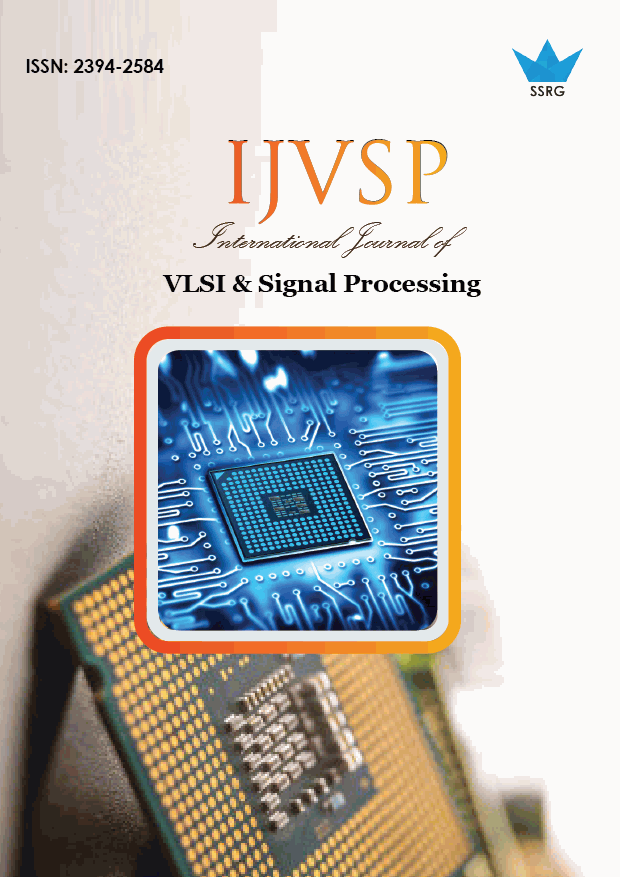Modified radix 12 Multiplier for reducing area of designed circuit with reduce time delay

| International Journal of VLSI & Signal Processing |
| © 2019 by SSRG - IJVSP Journal |
| Volume 6 Issue 3 |
| Year of Publication : 2019 |
| Authors : Akshay Sharma, Mr. Dinesh Chand Gupta |
How to Cite?
Akshay Sharma, Mr. Dinesh Chand Gupta, "Modified radix 12 Multiplier for reducing area of designed circuit with reduce time delay," SSRG International Journal of VLSI & Signal Processing, vol. 6, no. 3, pp. 6-9, 2019. Crossref, https://doi.org/10.14445/23942584/IJVSP-V6I3P102
Abstract:
A multiplier utilizing the radix-4 (or adjusted Booth) calculation is exceptionally effective because of the simplicity of incomplete item age, though the radix-8 Booth multiplier is delayed because of the unpredictability of producing the odd products of the multiplicand. In this paper, this issue is eased by the utilization of estimated structures. A surmised 2-bit snake is purposely intended for figuring the total of 1 and 2 of a double number. This snake requires a little territory, a low power and minimum delay. In this manner, the 2-bit snake is utilized to actualize the less critical segment of a recoding adder for creating the triple multiplicand with no conveys spread. In the quest for an exchange off among exactness and power utilization, two marked 12 * 12 bit rough radix-8 Booth multipliers are planned utilizing the surmised recoding snake with and without the truncation of various less critical bits in the halfway items. The proposed surmised multipliers are quicker and more power productive than the precise Booth multiplier. The multiplier with 15-bit truncation accomplishes the best by and large execution regarding equipment and precision when contrasted with other estimated Booth multiplier structures.
Keywords:
half adder, full adder, multiplier, multiplier, 8*8 radix multiplier, 16*16 radix multiplier.
References:
W. Razia Sultana, Sarat Kumar Sahoo, “Implementation of Cascaded H-Bridge Multilevel Inverter using MATLAB-DSP (ezDSP28335) Interfacing‖, Research Journal of Applied Sciences, Engineering and Technology 7(17): 3553-3560, 2014
[2] Lan-Da Van, Shuenn-Shyang Wang, and Wu-Shiung Feng, ―Design of the Lower Error Fixed-Width Multiplier and Its Application‖, IEEE Transactions on Circuits and Systems—Ii: Analog and Digital Signal Processing, Vol. 47, No. 10, October 2000.
[3] Xiaolong Ma, Jiangtao Xu, and Guican Chen, ―Improved Quantization Error Compensation Method for Fixed-Width Booth Multipliers‖, Hindawi Publishing Corporation VLSI Design Volume 2014
[4] Aiman Tabassum and Prof. M.T. Hasan, ―Efficient Design of Fixed Width Multiplier using Truncation and Error Compensation‖, International Research Journal of Engineering and Technology (IRJET) e-ISSN: 2395 -0056 Volume: 04 Issue: 04 | Apr -2017.
[5] Jiun-Ping Wang, Shiann-Rong Kuang, ―High-Accuracy Fixed-Width Modified Booth Multipliers for Lossy Applications‖, IEEE Transactions On Very Large Scale Integration (Vlsi) Systems, Vol. 19, No. 1, January 2011
[6] Amudha M and Sivasubramanian K, ―Design of Low-Error Fixed-Width Modified Booth Multiplier‖ International Journal of Electronics and Computer Science Engineering IJECSE, Volume1, Number 2 ISSN- 2277-1956.
[7] P. Lakshmi Neeraja and Ch. Rajesh Babu, ―Reliable Low Power Multiplier Design Using Reduced Precision Redundancy by Wallace Architecture,‖ International Journal for Research in Applied Science & Engineering Technology (IJRASET), Volume 6 Issue II, February 2018, ISSN: 2321-9653.
[8] Ila Chaudhary, Deepika Kularia and Romika Choudhary, ―Design and Comparison of High Speed Radix-8 and Radix-16 Booth’s Multipliers‖, International Journal of Computer Applications (0975 – 8887) Volume 181 – No.2, July 2018.

 10.14445/23942584/IJVSP-V6I3P102
10.14445/23942584/IJVSP-V6I3P102